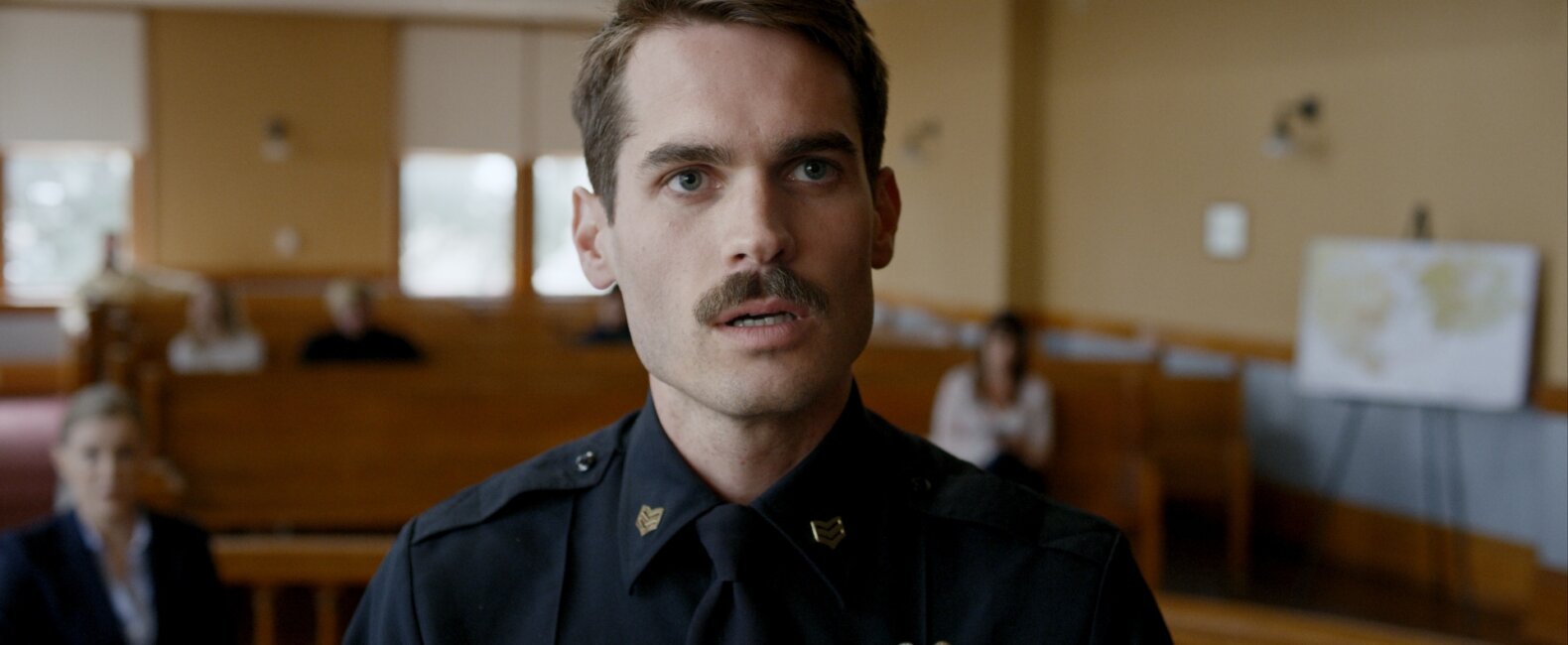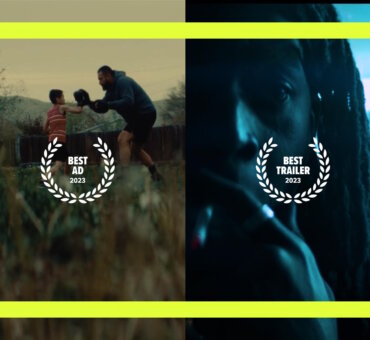Highlights
- Exploring the process of taking a short film and developing it into a feature film.
- Jim Cummings’ thoughts on directing and editing his own performance.
- Lowell Meyer’s vision behind the cinematography of Thunder Road.
- How having the right gear and crew can enhance a story.
- Pulling back the curtain on the distribution process.
- Thoughts on breaking into the film industry today.
In the hilarious yet heart-wrenching Thunder Road, Jim plays a southern police officer who attempts to raise his daughter as a love letter to his late mom, all while facing a personal and often hilarious meltdown as he struggles with his grief and pending divorce. A film that was introduced with the preface: “It’s okay to laugh when you think you should cry, and to cry when you should probably laugh.” We sat down with Jim Cummings and Filmsupply Filmmaker Lowell A. Meyer to discuss their award-winning feature.
To start off, how did you know that filmmaking was your medium for telling stories?
Jim Cummings: It’s the most collaborative and interactive art form with an audience, as well as with a team. You have more decisions to make while making a movie than when painting or even writing a book. I love movies and I grew up loving movies so much that it was a no-brainer. I knew filmmaking was going to be my outlet.
Lowell A. Meyer: For me, it didn’t really feel like a choice so much as an extension of my language abilities. I don’t think I’m the best writer in the world, even though I might try at times. But, taking photos and recording just seemed like a natural evolution in my upbringing. It’s what I just gravitated toward. When skateboarding, you’ll always see skaters filming their tricks and things like that. That was me. After a certain point, I realized that I was not going to be a pro-skater, but I had learned this new ability. An ability that’s so addicting that it’s hard to deny the fun and energy of making movies with your friends.
How did you create the idea for Thunder Road?
Jim Cummings: The idea behind the short film is actually really funny. A friend of mine told me this story about a buddy of his that sang a song at a funeral. I found that to be really interesting. I wasn’t an actor at the time. I mean, I guess I’m still not really an actor. But, I kept thinking that a eulogy would make a great monologue for an actor. As I was thinking about that, I heard the song Thunder Road by Bruce Springsteen on the radio. Then, the idea just progressed into a love letter to my mom. I rehearsed it on my drive to work, and that became the short film.
For the feature, it took me a year to have the idea for the opening scene to be the eulogy, rather than the climax. As soon as I had that idea, it was like, alright, well, this functions as a 90-minute narrative. After that, within five months we were shooting the feature. It took me that long to really find what was going to move me to tears and laughter. They always say if you have to ask yourself if you’re having a heart attack, you’re not having a heart attack. Then once it happens, you’re like, okay cool, this is what I have to do next.
What was it like re-shooting the short film as the opening scene of the feature?
Jim Cummings We were nervous the night before. We went through all the motions where you do all the prep work, you line up the locations, you talk with all the producers, you do all the physical stuff. You’re like, yeah, yeah, yeah we’re going to do it. We’ve got to recreate the Sundance-winning scene that got us here and it can’t just be an impersonation. It has to be authentic.
Lowell A. Meyer That’s the tricky part too! Since I didn’t shoot the short, I had to somehow split my brain into two compartments. On one side I had to do absolute justice to this incredible short film that I genuinely think is one of the best of all time. Then on the other side, not only copy the original but also make sure that somehow I’m a part of this new version that is different.
One difference between the short and the feature was the church. We were having a hard time finding a church to match with side aisles. In the short film there’s a center aisle that the dolly goes down and then Jim goes around and comes back on the left side. Without those aisles, we had to change the blocking of the shot. I know Jim and I were a little nervous about it, but I thought it made that final moment where he’s walking back to the pew much more dramatic.
Jim, tell us about the process of directing and editing your own performances.
Jim Cummings I had rehearsed about thousand times beforehand. I even turned the movie into a podcast. So anytime, anybody wanted to hear the movie before they showed up on set, they could listen to it as many times as they wanted. So, I already kind of knew how the movie was going to develop.
The rest of it was just trying to make the conversation seem natural and picking the best performances. If we ever didn’t get it, I kept saying, I can do it better. Then leaving the frame, and listening to Bob Dylan or whatever, and getting into the emotions of it all, running back in, and crying. Then, it was finding those shots in the editing room, and putting them into the movie.
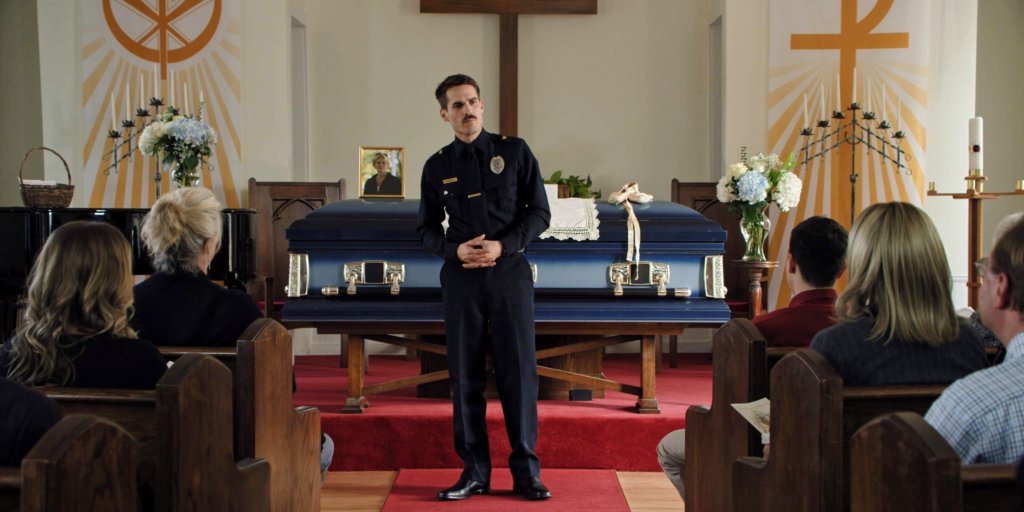
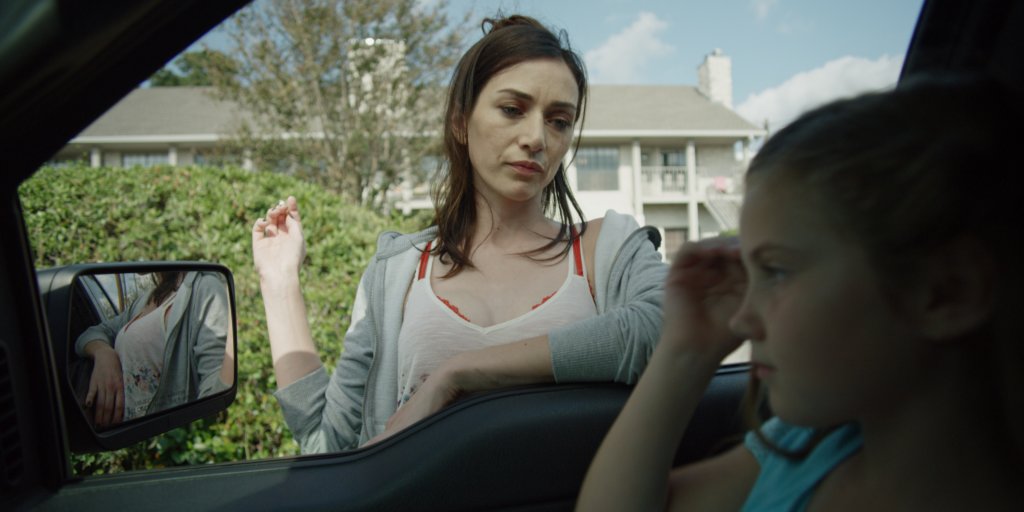
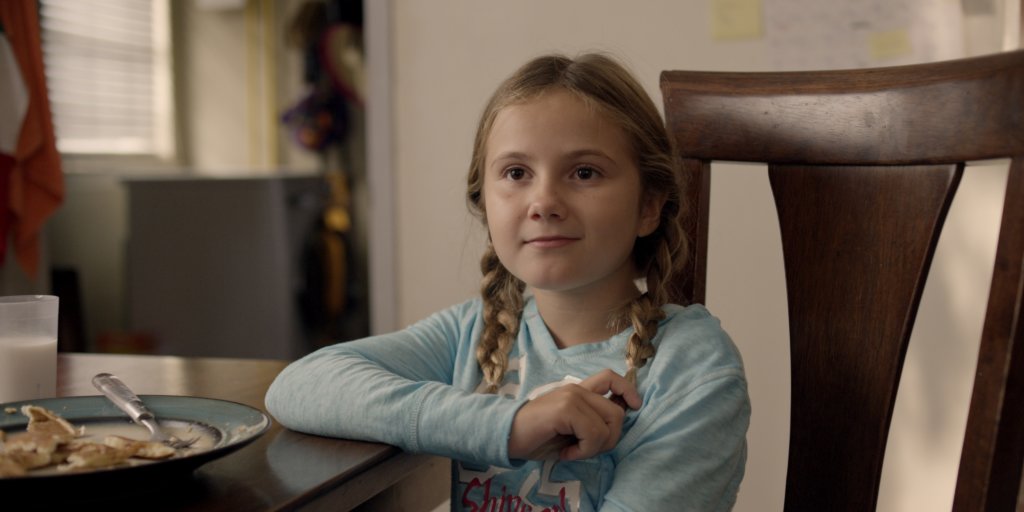
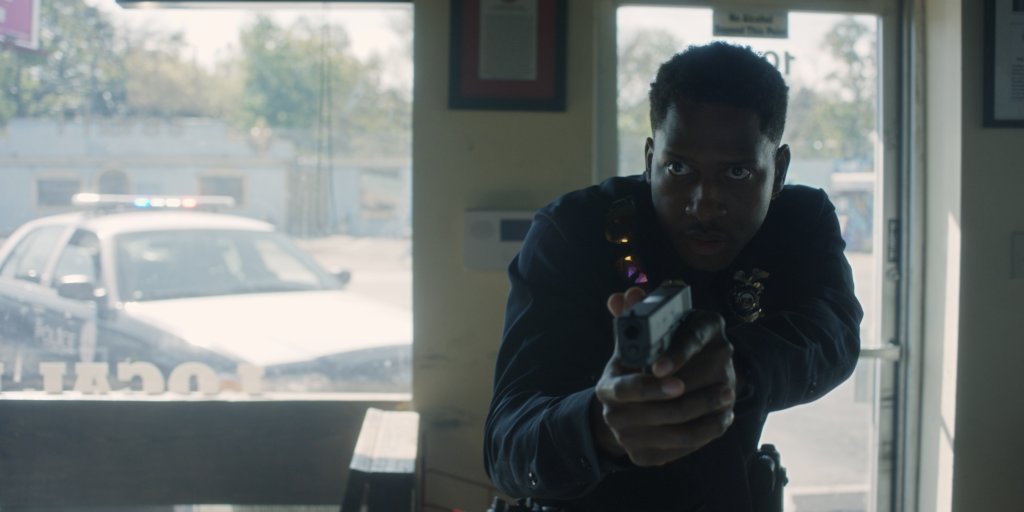
What was the vision for the cinematography of the film?
Lowell A. Meyer I think that it’s sometimes hard for me to be so self-reflective. I think my taste, styling, and personal aesthetic as a DP are always character and story driven. As opposed to a coolness factor, or some sort of specialty anamorphic lens. I’m much more about asking the question of, where can we sink the cinematography into the story? So that, in a weird way, that’s not the first thing you recognize. It’s about the character, the story, how much you relate, how much you connect. It’s also about a certain workflow, and on-set community. I try to be very collaborative, and very understanding of the actors process. Especially in this case, where the actor is the director. We had to make sure that everything was set up from a technical perspective beforehand.
Jim Cummings The camera definitely helps tell the story and was always a part of the conversation. We asked ourselves, “What is the emotionality of the scene? What are the setups and payoffs? What are the punchlines?” I feel that part of filmmaking is so absent now. Nobody uses the camera as a creative tool. It’s always about cross coverage, over the shoulder type of stuff. If you choose to focus on visual storytelling, it makes it a better story.
Lowell A. Meyer There are some DP’s who tend to be more technically minded. If they came onto a project like this, it might not matter if they don’t know how to tell a joke, or if they don’t understand comedy, or even if they don’t understand humor; It’s a very intangible aspect of being a cinematographer, you have to have a great depth of empathy, and humanity. If you don’t, you’re gonna do a disservice to any project you’re working on. If you understand how a joke setup works, you can get that across visually.
Like theater, comedy sometimes plays better in a wide, continuous shot. That’s part of the reason why we emphasize so many one takes in Thunder Road. It makes Jim’s character that much funnier, that much sadder, that much more real. If I didn’t understand that as a person, or as a filmmaker in my own right, then I would be doing the film a disservice as a cinematographer.
What will get us closer to the character? What will keep the camera moving, zooming, and being intimate? That, more than anything, was what motivated our technical and gear decisions.
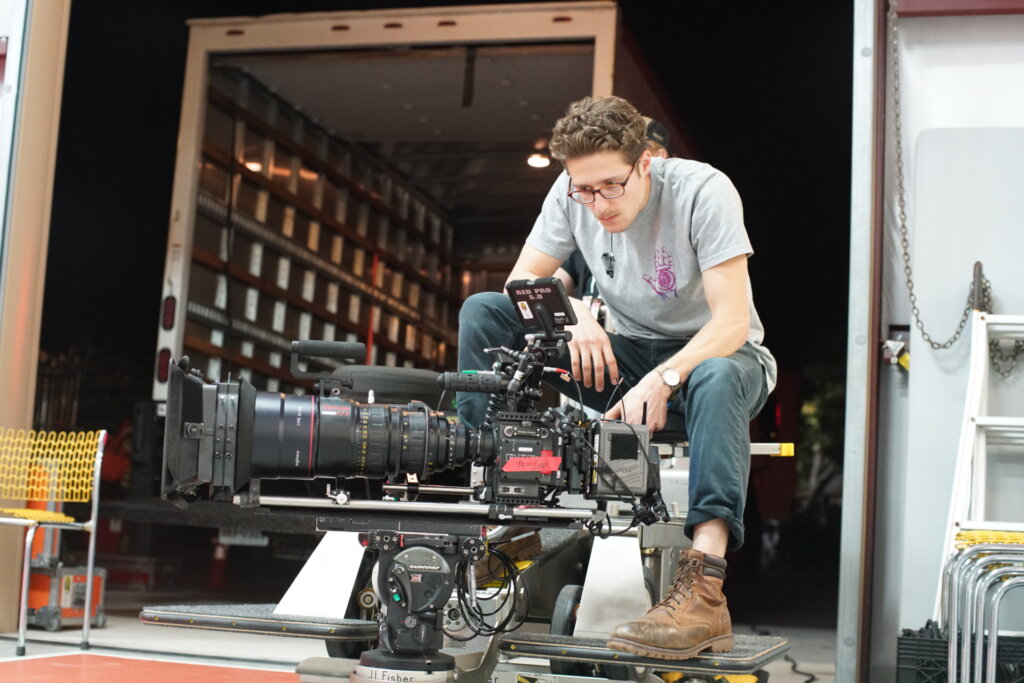
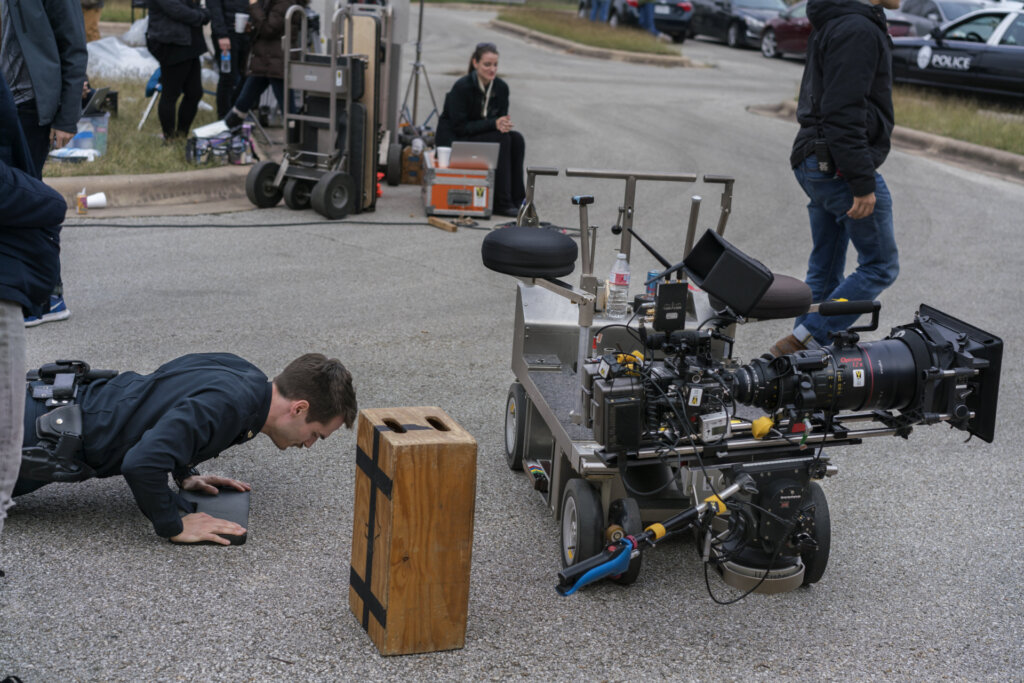
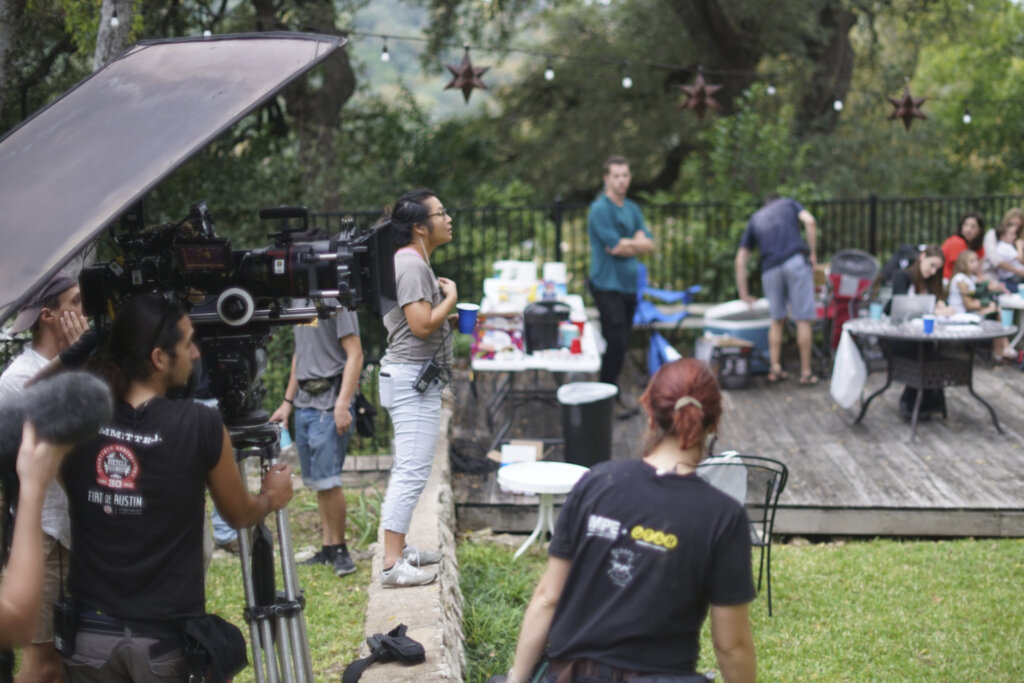
What choices were made with gear and crew to support the vision?
Lowell A. Meyer We used a RED Dragon because it’s just a great camera. Also, the 5K and 6K resolution of the camera was able to give us some wiggle room in some of our shots. There were some long one takes and we knew that those shots wouldn’t always be perfect. So, we put a 10% safety frame line in the cameras monitor and framed within that 90% area to have the room to stabilize a frame if needed.
In terms of lenses, we knew we were gonna need zooms. The short was filmed on a 24-290mm Optimo zoom, which I’ve used a bunch and personally love. However, one thing about the lens is that it’s massive and extremely heavy. The lens even has its own handle. There were instances where we couldn’t use it, but we still wanted to have a zoom in smaller places, such as Jim’s car. We also had a short zoom, the Fujinon Cabrio, 19-90mm. My first AC, MJ Marcinik, was incredible. I can’t even fathom how hard his job was to keep everything in focus. Especially for these one takes where for the next 13 minutes, nothing can go wrong.
We also ordered a lot of dolly track. I believe the first crew member I hired was our dolly grip, Jere Bryan Free. He would be one of the most important, creative crew members, and he was just an absolute wonder. He laid 50 or 60 feet of dolly grip a day for us. He did it all with a broken hand.
Jim Cummings I also want to add that he had a broken hand from punching a boar.
Lowell A. Meyer He was great! We also had a great gaffer, Morgan Bond. Her and I basically picked our lighter kit that we knew would be the most nimble and efficient while also give us creative possibility. Jim and I are both so camera minded that, we want to make the scenes the best they can be from a camera perspective, and then light and shape as much as possible around that. We always wanted to compose the most beautiful, cinematic, and emotionally resonant shot, and then lit around that.
What was the distribution process like?
Jim Cummings To give you the Cliff’s Notes version of the process, we applied to the Creative Distribution Fellowship with Sundance, we got it. We were one of three films. We’re incredibly lucky. We went through an aggregator called Quiver Digital. It’s an iTunes aggregator that allows you to upload your movie, and it costs like $1200-$2000 at most to pitch to different platforms like Amazon and Comcast and DirecTV and iTunes, Google Play, etc. It’s really what any smaller distribution company would use. So we decided, that it would be better if we just cut the trailer ourselves and build the poster, as well as the marketing materials. We built Facebook ads and did exactly what any modern distribution company that’s worth their salt would do, and it’s paid off. It’s been unbelievable.
It has been this grassroots thing from the beginning of the Kickstarter campaign to building a summer camp and making this movie with friends and family in their backyards. So, the distribution kind of had to be the same way of just using small teams and not going through the proper channels. I think the real future of independent feature film distribution is going to be very similar to YouTube where you don’t need to hire somebody or a marketing company to upload your movie, you can do it yourself and everybody should.
Lowell A. Meyer There are new digital avenues that have popped up. Even Rotten Tomatoes has this online presence where you can trust what they say is a good movie. Yeah, there’s a lot of room for things like that. Even just looking at what you guys are doing, it definitely sounds like Filmsupply is the next big thing.
So you’ve won a few festivals now, what do you think the process of breaking into the industry looks like today?
Jim Cummings I always felt like festivals were this club that I wasn’t a part of, or that it was this glass castle in the sky that you only dream of getting into. If you can demystify it and say that anybody can do this shit… You can make great films! I really feel like I wish I had heard that as a kid growing up. It would have empowered me to create more stuff.
Lowell A. Meyer It’s funny that Jim presents it that way because that’s basically the way that it had been presented to me as a DP by DP mentors. I remember going to the American Society of Cinematographers and they had these open houses where I met Oscar-nominated DPs. During this time, I was an AC trying to become a DP or even becoming a DP on the side but not making a living from it and not carrying the projects that were creatively fulfilling like Thunder Road. I just remember being like, “What I do? How do I get to where you are?” People now ask me that all the time too, which is very bizarre. I give the same response I heard, which is “Just go out there and shoot. Just whatever you can do, whenever you can get a camera and lights, just do it, and make the best of it.” I don’t think that anyone who has “made it” has done it without an extreme amount of tenacity, desire, and persistence.
I think anybody who is willing to wait for something to come along is wasting time and giving that time to people who aren’t waiting around. When you’re waiting for someone else to advance your career, other people are seizing their own opportunities and being the people who get to festivals. Literally, just take the cheapest DSLR you can get on the market and filming something funny with your friends on a Saturday. That will get you farther than waiting a day for someone to call.
There is a really great Ira Glass quote about being distraught because the films you’re making aren’t as good as your tastes and that your taste gets better faster than your abilities to make something. You get discouraged because you’re like, “Man, my shots don’t look as good as Roger Deakins. I know Roger Deakins now, I know he’s a great DP. Why can’t I make the things he does even if I’m using similar tools?” And you just have to break through that time. Part of making movies is making shitty movies. If you get discouraged at your first shitty movie or your second shitty movie or even your third or fourth or fifth, you’re not going to ever break through and make your first good movie, and then your first great movie and then your fifth great movie.
Jim Cummings I say you have to learn the language. You have to learn how you speak the language of film. It’s important. You can read it in books and you can watch it in movies, but you have to learn how you do it.
